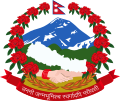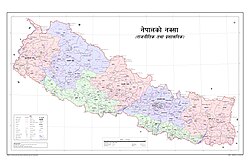**Geography and Biodiversity of Nepal:**
– Nepal is a landlocked country in South Asia with diverse geography, including plains and tall mountains.
– It is approximately 800km long and 200km wide, covering an area of 147,516 sq km.
– The country’s geology began evolving around 75 million years ago due to tectonic plate movements, leading to the formation of the Himalayas.
– Nepal is divided into three main regions: Himal (mountainous), Pahad (hilly), and Terai (lowland plains).
– Mount Everest, the world’s highest peak, lies on the Nepal-China border.
– Nepal hosts rich biodiversity, with a significant variety of plants and animals.
– The country’s forest cover is 40.36% of the total land area, with diverse ecosystems ranging from sub-tropical grasslands to alpine shrubs and meadows.
– Nepal is home to endemic species of mammals, birds, reptiles, amphibians, fish, and butterflies.
– Conservation efforts include national parks, wildlife reserves, conservation areas, buffer zones, and wetlands registered under international conventions like the Ramsar Convention.
**History and Cultural Heritage of Nepal:**
– Ancient Nepal saw the arrival of the first modern humans from Africa, with evidence of settlements dating back to 6500 BC.
– Various civilizations, including the Indus Valley, influenced Nepal, with diverse settlements of Dravidian, Tibeto-Burman, and Indo-Aryan origins.
– Nepal has a multi-ethnic, multi-lingual, and multi-religious population.
– The country has a rich cultural heritage with influences from Hinduism and Buddhism.
– Traditional music, dance, festivals, and handicrafts like pottery, weaving, and metalwork are integral to Nepalese culture.
– Nepal’s art and architecture development flourished under kingdoms like the Mallas, with notable sites like Kathmandu, Patan, and Bhaktapur Durbar Squares.
– The birthplace of Gautama Buddha in Lumbini and historical influences from Maurya Emperor Ashoka and Gupta Empire are significant cultural landmarks.
**Demographics and Economy of Nepal:**
– In 2021, Nepal’s religious demographics included 81.19% Hinduism, 8.21% Buddhism, 5.09% Islam, and other minority religions.
– The ethnic breakdown comprises groups like Rai, Gurung, Limbu, and others.
– Nepal ranked 142nd in the Human Development Index in 2019, with a medium HDI of 0.602.
– The country’s currency is the Nepalese rupee (NPR), and it operates on Nepal Standard Time (UTC+05:45).
– Agriculture is a significant sector employing a large portion of the population, with tourism, remittances, and hydropower contributing to the economy.
– Challenges to economic development include political instability, natural disasters, and infrastructure limitations.
**Political Landscape and Government Structure of Nepal:**
– Nepal is a secular federal parliamentary republic divided into seven provinces.
– The country is a member of the UN, with friendship treaties with India and China, hosting the SAARC secretariat.
– Nepal has the fifth-largest armed forces in South Asia, known for its Gurkha history and contributions to UN peacekeeping operations.
– The political history includes transitions from monarchy to secular republic, with the introduction of parliamentary democracy in 1951.
– Major political parties in Nepal include the Communist Party of Nepal, Nepali Congress, and Rastriya Swatantra Party.
– The government structure comprises a President, Prime Minister, and seven national political parties in the federal parliament, operating under the Constitution of Nepal.
**Challenges, Achievements, and Conservation Efforts in Nepal:**
– Nepal faces challenges from human encroachment on wildlife habitats, but conservation efforts have led to a decrease in poaching.
– Progress has been made in expanding protected areas, national parks, and engaging in community forestry.
– Political movements have shaped Nepal’s transition to a democratic republic, with efforts contributing to both conservation and local economies.
– Conservation programs have helped increase the population of endangered species, with initiatives like vulture restaurants and breeding programs aiding wildlife conservation.
– Nepal’s efforts in biodiversity conservation have positioned it as a global player in preserving its natural heritage.
Nepal, officially the Federal Democratic Republic of Nepal, is a landlocked country in South Asia. It is mainly situated in the Himalayas, but also includes parts of the Indo-Gangetic Plain. It borders the Tibet Autonomous Region of China to the north, and India to the south, east, and west, while it is narrowly separated from Bangladesh by the Siliguri Corridor, and from Bhutan by the Indian state of Sikkim. Nepal has a diverse geography, including fertile plains, subalpine forested hills, and eight of the world's ten tallest mountains, including Mount Everest, the highest point on Earth. Kathmandu is the nation's capital and the largest city. Nepal is a multi-ethnic, multi-lingual, multi-religious and multi-cultural state, with Nepali as the official language.
Federal Democratic Republic of Nepal | |
|---|---|
| Motto: जननी जन्मभूमिश्च स्वर्गादपि गरीयसी (Sanskrit) Janani Janmabhumishcha Swargadapi Gariyasi "Mother and Motherland are Greater Than Heaven" | |
| Anthem: सयौँ थुँगा फूलका (Nepali) Sayaun Thunga Phulka "Made of Hundreds of Flowers" | |
Location of Nepal in dark green; territory claimed but controlled by India shown in light green | |
| Capital and largest city | Kathmandu 28°10′N 84°15′E / 28.167°N 84.250°E |
| Official languages | Nepali |
| Recognised national languages | All mother-tongues (see Languages of Nepal) |
| Ethnic groups (2011) | |
| Religion (2021) | |
| Demonym(s) | |
| Government | Federal parliamentary republic |
| Ram Chandra Poudel | |
| Ram Sahaya Yadav | |
| Pushpa Kamal Dahal | |
| Bishowambhar Prasad Shrestha | |
| Legislature | Federal Parliament |
| National Assembly | |
| House of Representatives | |
| Formation | |
| 25 September 1768 | |
| 4 March 1816 | |
| 21 December 1923 | |
| 28 May 2008 | |
| 20 September 2015 | |
| Area | |
• Total | 147,516 km2 (56,956 sq mi) (93rd) |
• Water (%) | 2.8% |
| Population | |
• 2022 estimate | 30,666,598 (49th) |
• Density | 180/km2 (466.2/sq mi) (72nd) |
| GDP (PPP) | 2023 estimate |
• Total | |
• Per capita | |
| GDP (nominal) | 2023 estimate |
• Total | |
• Per capita | |
| Gini (2010) | 32.8 medium |
| HDI (2019) | medium (142nd) |
| Currency | Nepalese rupee (Rs, रू) (NPR) |
| Time zone | UTC+05:45 (Nepal Standard Time) |
| Date format | YYYY/MM/DD |
| Driving side | left |
| Calling code | +977 |
| ISO 3166 code | NP |
| Internet TLD | .np |
The name "Nepal" is first recorded in texts from the Vedic period of the Indian subcontinent, the era in ancient Nepal when Hinduism was founded, the predominant religion of the country. In the middle of the first millennium BC, Gautama Buddha, the founder of Buddhism, was born in Lumbini in southern Nepal. Parts of northern Nepal were intertwined with the culture of Tibet. The centrally located Kathmandu Valley is intertwined with the culture of Indo-Aryans, and was the seat of the prosperous Newar confederacy known as Nepal Mandala. The Himalayan branch of the ancient Silk Road was dominated by the valley's traders. The cosmopolitan region developed distinct traditional art and architecture. By the 18th century, the Gorkha Kingdom achieved the unification of Nepal. The Shah dynasty established the Kingdom of Nepal and later formed an alliance with the British Empire, under its Rana dynasty of premiers. The country was never colonised but served as a buffer state between Imperial China and British India. Parliamentary democracy was introduced in 1951 but was twice suspended by Nepalese monarchs, in 1960 and 2005. The Nepalese Civil War in the 1990s and early 2000s resulted in the establishment of a secular republic in 2008, ending the world's last Hindu monarchy.
The Constitution of Nepal, adopted in 2015, affirms the country as a secular federal parliamentary republic divided into seven provinces. Nepal was admitted to the United Nations in 1955, and friendship treaties were signed with India in 1950 and China in 1960. Nepal hosts the permanent secretariat of the South Asian Association for Regional Cooperation (SAARC), of which it is a founding member. Nepal is also a member of the Non-Aligned Movement and the Bay of Bengal Initiative. The Nepalese Armed Forces are the fifth-largest in South Asia; and are notable for their Gurkha history, particularly during the world wars, and has been a significant contributor to United Nations peacekeeping operations.




